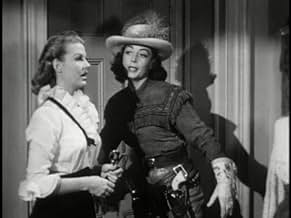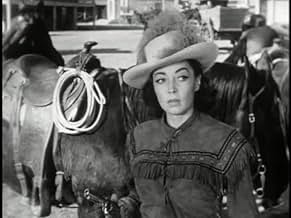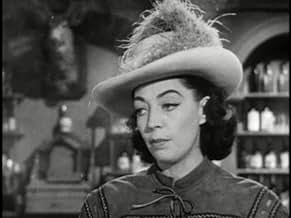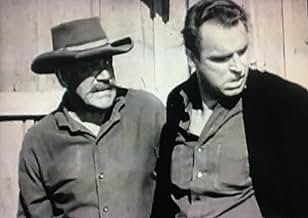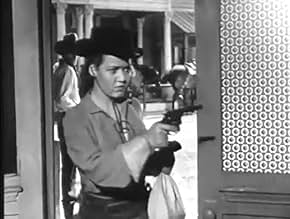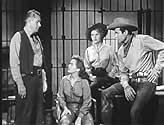Eisenbahndetektiv Matt Clark
Originaltitel: Stories of the Century
IMDb-BEWERTUNG
7,0/10
220
IHRE BEWERTUNG
Füge eine Handlung in deiner Sprache hinzuRailroad detective Matt Clark roams the west, tracking down outlaws and bandits who are preying on the railroad.Railroad detective Matt Clark roams the west, tracking down outlaws and bandits who are preying on the railroad.Railroad detective Matt Clark roams the west, tracking down outlaws and bandits who are preying on the railroad.
- 1 Primetime Emmy gewonnen
- 1 wins total
Folgen durchsuchen
Empfohlene Bewertungen
"Stories of the Century" (1954-55) was a 39-episode TV series produced by Republic Pictures that focused on the manhunts for famous western outlaws. The same hero, a railroad detective named Matt Clark, appeared every week, with one female partner in the first season and a new one in the second. His trademark narration opened with the same line in each episode, "The official newspaper files of the early west record many stories of famous and notorious characters of that period," following which he'd have choice words about the episode's highlighted outlaw(s).
The amusing conceit of this series is that the hero is either present or close by at the apprehension or killing of nearly every famous (or not-so-famous) western outlaw from the 1850s (Tom Bell) to the early 20th century (Tom Horn), from Missouri (Jesse James) to California (Black Bart). Yet Mr. Clark looks the same in every episode and the setting is the same old western town set that Republic Pictures used in hundreds of B-westerns, even when the action shifts to a big city (e.g. Kansas City or San Francisco). The series was cheaply shot but benefited from the inclusion of all manner of stunts and action scenes culled from Republic's extensive library of westerns. For instance, a chase involving wagons carting tanks of oil in the Black Jack Ketchum episode comes from the John Wayne western, WAR OF THE WILDCATS (1943). Captain Quantrill's murderous raid on Lawrence, Kansas in 1863 comes from Raoul Walsh's well-budgeted DARK COMMAND (1940). The actors in the series often had to wear costumes that matched the ones worn by the characters in the stock footage.
Some episodes relied on lots of stock footage, like "Ben Thompson" with its climactic fire in the wheat fields, while others consisted of nearly all new footage, like "The Dalton Gang," in which the raid on Coffeyville, Kansas and subsequent shootout were all newly staged for the episode. The action is quite impressive, directed as it is by Republic's top house director William Witney. (Witney did all of Season One and part of Season Two. Franklin Adreon directed the rest of Season Two.)
The series was best when the villains were formidable and the guest stars were top-ranked. Lee Van Cleef (FOR A FEW DOLLARS MORE) turns up as Jesse James in the very first episode. Billy the Kid is played by Richard Jaeckel, who would appear as a supporting character in two later films about Billy, CHISUM and PAT GARRETT AND BILLY THE KID. Marie Windsor, who'd already played female outlaws in Republic westerns (HELLFIRE, DAKOTA LIL), plays Belle Starr. Ex-con Leo Gordon (RIOT IN CELL BLOCK 11) plays Bill Doolin. A pre-Davy Crockett Fess Parker plays one of the Dalton Brothers. Former Tarzan Bruce Bennett plays Captain Quantrill. Henry Brandon (Chief Scar in THE SEARCHERS) plays cattle rustler Nate Champion. Other good episodes showcase The Younger Brothers, Johnny Ringo, Jack Slade, Tom Horn, and Cattle Kate.
Western regular Jim Davis played Matt Clark as a brusque, hard-line lawman, quick with both fists and guns. He gave no quarter and made no secret of wanting to see the outlaws hanged. In most Republic westerns I've seen, the villains were usually landowners, cattle barons, bankers, or businessmen with ulterior motives, never ordinary criminals. Not here. For once, the bad guys are psychotic killers, unrepentant thieves, and malcontents. In only a handful of episodes do we feel any sympathy for the lawbreakers, chief among them Doc Holliday, of course, who famously sided with Wyatt Earp in the Gunfight at the O.K. Corral and, yep, Matt was there. Others include the Cherokee Kid, a victim of racial prejudice, and Little Britches, a spunky but troubled young girl who falls in with older men who take advantage of her.
Matt Clark's female assistants were Frances "Frankie" Adams (Mary Castle) and Margaret "Jonesy" Jones (Kristine Miller), who represented stark contrasts in style. Frankie was no-nonsense and unassuming. She went undercover quite frequently, sometimes as bargirls and saloon entertainers, and blended in very well. She was unfazed by the toughest hombres and fought female outlaws hand-to-hand more than once. This was the first time I've ever seen Ms. Castle and she's quite a revelation. Miller, on the other hand, was a fashion plate who looked stunning in whatever outfits the story dictated. She carried herself like a lady and spoke with precise diction. She was never terribly convincing when operating undercover. She played her character as an ardent feminist who lamented having to do paperwork. She also reached out to female victims of the outlaws as in the episode where she comforts and nurses a Mexican woman who'd been abducted and raped by the Apache Kid. Matt often engaged in flirtatious banter with both women, although more often with Jonesy, who seemed to welcome it more.
There were excellent supporting players in some episodes and they provided some of the series' most powerful scenes. Black actress Louise Beavers (IMITATION OF LIFE, 1934) plays Aunt Nellie, the woman who'd raised the Younger Brothers, and she breaks our hearts when she makes the difficult decision to turn against them. Lisa Fusaro plays the Indian mother of the Cherokee Kid and has an angry outburst in court at his sentencing that takes the series to a whole new emotional level. There was also a consistent effort made to cast ethnically appropriate actors in the Indian and Mexican roles that popped up.
I watched 38 of the 39 episodes for this review. Some were better than others, as cited above, while some were fairly dull, thanks to minor guest actors (Don Haggerty as Sam Bass) and uninteresting no-name outlaws (L.H. Musgrove, anyone?). Still, it's quite an unusual western series, with an intriguing cross-section of western history and a steadier supply of action and violence than we got in the more standardized TV westerns of the later 1950s.
The amusing conceit of this series is that the hero is either present or close by at the apprehension or killing of nearly every famous (or not-so-famous) western outlaw from the 1850s (Tom Bell) to the early 20th century (Tom Horn), from Missouri (Jesse James) to California (Black Bart). Yet Mr. Clark looks the same in every episode and the setting is the same old western town set that Republic Pictures used in hundreds of B-westerns, even when the action shifts to a big city (e.g. Kansas City or San Francisco). The series was cheaply shot but benefited from the inclusion of all manner of stunts and action scenes culled from Republic's extensive library of westerns. For instance, a chase involving wagons carting tanks of oil in the Black Jack Ketchum episode comes from the John Wayne western, WAR OF THE WILDCATS (1943). Captain Quantrill's murderous raid on Lawrence, Kansas in 1863 comes from Raoul Walsh's well-budgeted DARK COMMAND (1940). The actors in the series often had to wear costumes that matched the ones worn by the characters in the stock footage.
Some episodes relied on lots of stock footage, like "Ben Thompson" with its climactic fire in the wheat fields, while others consisted of nearly all new footage, like "The Dalton Gang," in which the raid on Coffeyville, Kansas and subsequent shootout were all newly staged for the episode. The action is quite impressive, directed as it is by Republic's top house director William Witney. (Witney did all of Season One and part of Season Two. Franklin Adreon directed the rest of Season Two.)
The series was best when the villains were formidable and the guest stars were top-ranked. Lee Van Cleef (FOR A FEW DOLLARS MORE) turns up as Jesse James in the very first episode. Billy the Kid is played by Richard Jaeckel, who would appear as a supporting character in two later films about Billy, CHISUM and PAT GARRETT AND BILLY THE KID. Marie Windsor, who'd already played female outlaws in Republic westerns (HELLFIRE, DAKOTA LIL), plays Belle Starr. Ex-con Leo Gordon (RIOT IN CELL BLOCK 11) plays Bill Doolin. A pre-Davy Crockett Fess Parker plays one of the Dalton Brothers. Former Tarzan Bruce Bennett plays Captain Quantrill. Henry Brandon (Chief Scar in THE SEARCHERS) plays cattle rustler Nate Champion. Other good episodes showcase The Younger Brothers, Johnny Ringo, Jack Slade, Tom Horn, and Cattle Kate.
Western regular Jim Davis played Matt Clark as a brusque, hard-line lawman, quick with both fists and guns. He gave no quarter and made no secret of wanting to see the outlaws hanged. In most Republic westerns I've seen, the villains were usually landowners, cattle barons, bankers, or businessmen with ulterior motives, never ordinary criminals. Not here. For once, the bad guys are psychotic killers, unrepentant thieves, and malcontents. In only a handful of episodes do we feel any sympathy for the lawbreakers, chief among them Doc Holliday, of course, who famously sided with Wyatt Earp in the Gunfight at the O.K. Corral and, yep, Matt was there. Others include the Cherokee Kid, a victim of racial prejudice, and Little Britches, a spunky but troubled young girl who falls in with older men who take advantage of her.
Matt Clark's female assistants were Frances "Frankie" Adams (Mary Castle) and Margaret "Jonesy" Jones (Kristine Miller), who represented stark contrasts in style. Frankie was no-nonsense and unassuming. She went undercover quite frequently, sometimes as bargirls and saloon entertainers, and blended in very well. She was unfazed by the toughest hombres and fought female outlaws hand-to-hand more than once. This was the first time I've ever seen Ms. Castle and she's quite a revelation. Miller, on the other hand, was a fashion plate who looked stunning in whatever outfits the story dictated. She carried herself like a lady and spoke with precise diction. She was never terribly convincing when operating undercover. She played her character as an ardent feminist who lamented having to do paperwork. She also reached out to female victims of the outlaws as in the episode where she comforts and nurses a Mexican woman who'd been abducted and raped by the Apache Kid. Matt often engaged in flirtatious banter with both women, although more often with Jonesy, who seemed to welcome it more.
There were excellent supporting players in some episodes and they provided some of the series' most powerful scenes. Black actress Louise Beavers (IMITATION OF LIFE, 1934) plays Aunt Nellie, the woman who'd raised the Younger Brothers, and she breaks our hearts when she makes the difficult decision to turn against them. Lisa Fusaro plays the Indian mother of the Cherokee Kid and has an angry outburst in court at his sentencing that takes the series to a whole new emotional level. There was also a consistent effort made to cast ethnically appropriate actors in the Indian and Mexican roles that popped up.
I watched 38 of the 39 episodes for this review. Some were better than others, as cited above, while some were fairly dull, thanks to minor guest actors (Don Haggerty as Sam Bass) and uninteresting no-name outlaws (L.H. Musgrove, anyone?). Still, it's quite an unusual western series, with an intriguing cross-section of western history and a steadier supply of action and violence than we got in the more standardized TV westerns of the later 1950s.
'Big' Jim Davis, as Matt Clark, Railroad Detective, traveled west each week to aid in the capture of one of history's notable badmen(or women). At times, Clark's appearance at the scene seems somewhat contrived, as in just "happening" to be in town when Ford shoots Jesse James. The stories do have some limited educational value, as each one sticks to the basic facts, although production values for the series were decidedly low budget. One thing I could never figure out...one week Clark would chase Quantrill in 1863, the next Tom Horn in 1903...30 years apart...yet he never aged!
In spite of an awful and even misleading title, this adventure series disguised as a detective show does provide some interesting history of the latter part of the nineteenth century. The narration works well, though maybe not in the voice of its star, Jim Davis. The editing, mixing in stock footage from Republic Pictures, is pretty good, and this show provides more action sequences of stampedes (horse and cattle) and stagecoach and wagon disasters than any western I know.
The stories are pretty good, examining the rampages and ends of some of the most notorious outlaws in western history (all supposedly based on true facts). The sets are very good--though as with much of early TV in the mid-1950s, you can see the abrupt change from location shooting to the studio set. And continuity problems are not uncommon.
The acting is okay, especially from some of the guest stars, many of whom were just starting out in television.
Overall, it works, and I wish they had continued--but, as another reviewer pointed out, I guess they ran out of true-to-life bad guys whose stories they could tell. I rated the series a 9 because it's better than an 8. And the location landscape shots (lots of well-filmed chance sequences) are wonderful.
The stories are pretty good, examining the rampages and ends of some of the most notorious outlaws in western history (all supposedly based on true facts). The sets are very good--though as with much of early TV in the mid-1950s, you can see the abrupt change from location shooting to the studio set. And continuity problems are not uncommon.
The acting is okay, especially from some of the guest stars, many of whom were just starting out in television.
Overall, it works, and I wish they had continued--but, as another reviewer pointed out, I guess they ran out of true-to-life bad guys whose stories they could tell. I rated the series a 9 because it's better than an 8. And the location landscape shots (lots of well-filmed chance sequences) are wonderful.
TV's "Stories Of The Century" (1954-1955) was set in the American "Old West" where Matt Clark was a staunch, no-nonsense Railroad Detective whose territorial boundaries often extended well-beyond that of just the confined restrictions of the railroads.
Working together with either one of his trustworthy female sidekicks, Frankie Adams or Margaret Jones - Matt Clark could always be counted on to bring to justice some of the most notorious badmen (and bad women) whoever dared to challenge the law in this untamed frontier of America.
For the most part - "Stories Of The Century" was a fairly entertaining TV Western (from yesteryear) that certainly contained plenty of violence and gun-play in order to move its fast-paced stories about rough'n'rugged cowboys along.
Working together with either one of his trustworthy female sidekicks, Frankie Adams or Margaret Jones - Matt Clark could always be counted on to bring to justice some of the most notorious badmen (and bad women) whoever dared to challenge the law in this untamed frontier of America.
For the most part - "Stories Of The Century" was a fairly entertaining TV Western (from yesteryear) that certainly contained plenty of violence and gun-play in order to move its fast-paced stories about rough'n'rugged cowboys along.
This unassuming, fairly routine series deserves credit in the TV history books for two reasons: it was the first to win an Emmy award for best syndicated series, and it was the very first show to come from the fabled studios of Republic Pictures, known for its low-budget but high-powered shoot-em-ups in the 30's and 40's.
Republic was one of the first Hollywood studios to make a leap into the small screen, which was still in its infancy. But the studios' tenure as producer of TV pulp fiction would be brief. After this show, they would later dabble with the other format that they were known for, the adventure serial, with "Commando Cody", as well as other series, but like this one, they didn't last longer than 39 episodes. Also, Republic was in its last stages as a studio; it would finish out its tenure in Hollywood as rental stages for several Revue Studio series such as "Soldiers of Fortune", the original "Dragnet", and "Kit Carson", before finally shutting its doors in 1959.
Anyway, "Stories of the Century" wasn't that bad of an oater, its calling card was tales based on authentic figures in Western history, mainly outlaws like Black Bart, Johnny Ringo, John Wesley Hardin, The Dalton Bros. and the like. The late Jim Davis, best known for his role as the Ewing patriarch in "Dallas", put in an amiable job in the lead role as Matt Clark, a fictional railroad detective who has to contend with said outlaws, played by veteran and soon-to-be veteran character actors.
Two amazing facts here: The incidents would take place in different time lines, some in the 1880's, some at the turn of the century, but Clark never ages. And also, Matt has the good luck to saddle himself with two lovely female detectives as sidekicks, Frankie Adams, played by Mary Castle, and her replacement, Margaret "Jonesy" Jones, by Kristine Miller. The Lone Ranger could only wish for lady companionship. You can only spend such time with Tonto for so long.
"Stories Of The Century" is a Studio City TV production from Republic Pictures Corp. 39 episodes were made during 1954, all 39 of which are in public domain and on DVD.
Republic was one of the first Hollywood studios to make a leap into the small screen, which was still in its infancy. But the studios' tenure as producer of TV pulp fiction would be brief. After this show, they would later dabble with the other format that they were known for, the adventure serial, with "Commando Cody", as well as other series, but like this one, they didn't last longer than 39 episodes. Also, Republic was in its last stages as a studio; it would finish out its tenure in Hollywood as rental stages for several Revue Studio series such as "Soldiers of Fortune", the original "Dragnet", and "Kit Carson", before finally shutting its doors in 1959.
Anyway, "Stories of the Century" wasn't that bad of an oater, its calling card was tales based on authentic figures in Western history, mainly outlaws like Black Bart, Johnny Ringo, John Wesley Hardin, The Dalton Bros. and the like. The late Jim Davis, best known for his role as the Ewing patriarch in "Dallas", put in an amiable job in the lead role as Matt Clark, a fictional railroad detective who has to contend with said outlaws, played by veteran and soon-to-be veteran character actors.
Two amazing facts here: The incidents would take place in different time lines, some in the 1880's, some at the turn of the century, but Clark never ages. And also, Matt has the good luck to saddle himself with two lovely female detectives as sidekicks, Frankie Adams, played by Mary Castle, and her replacement, Margaret "Jonesy" Jones, by Kristine Miller. The Lone Ranger could only wish for lady companionship. You can only spend such time with Tonto for so long.
"Stories Of The Century" is a Studio City TV production from Republic Pictures Corp. 39 episodes were made during 1954, all 39 of which are in public domain and on DVD.
Wusstest du schon
- WissenswertesMuch of the action consisted of footage lifted from various westerns produced by Republic Pictures over the years. Republic produced this series through its subsidiary, Hollywood Television Service.
- Zitate
Matt Clark: I don't care how right a man is. As soon as he picks up a gun, he's wrong from the start!
- VerbindungenReferences Banditen am Scheideweg (1949)
Top-Auswahl
Melde dich zum Bewerten an und greife auf die Watchlist für personalisierte Empfehlungen zu.
- How many seasons does Stories of the Century have?Powered by Alexa
Details
- Erscheinungsdatum
- Herkunftsland
- Sprache
- Auch bekannt als
- Stories of the Century
- Drehorte
- Produktionsfirmen
- Weitere beteiligte Unternehmen bei IMDbPro anzeigen
- Laufzeit30 Minuten
- Farbe
- Seitenverhältnis
- 1.33 : 1
Zu dieser Seite beitragen
Bearbeitung vorschlagen oder fehlenden Inhalt hinzufügen



